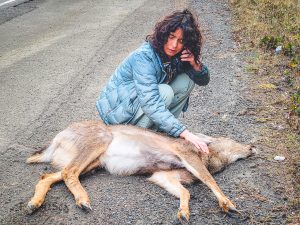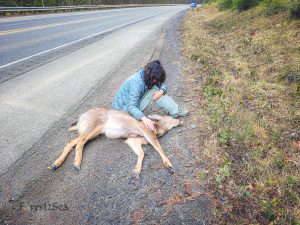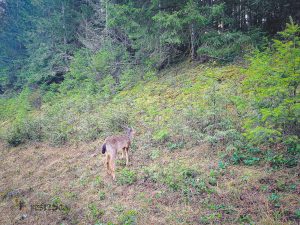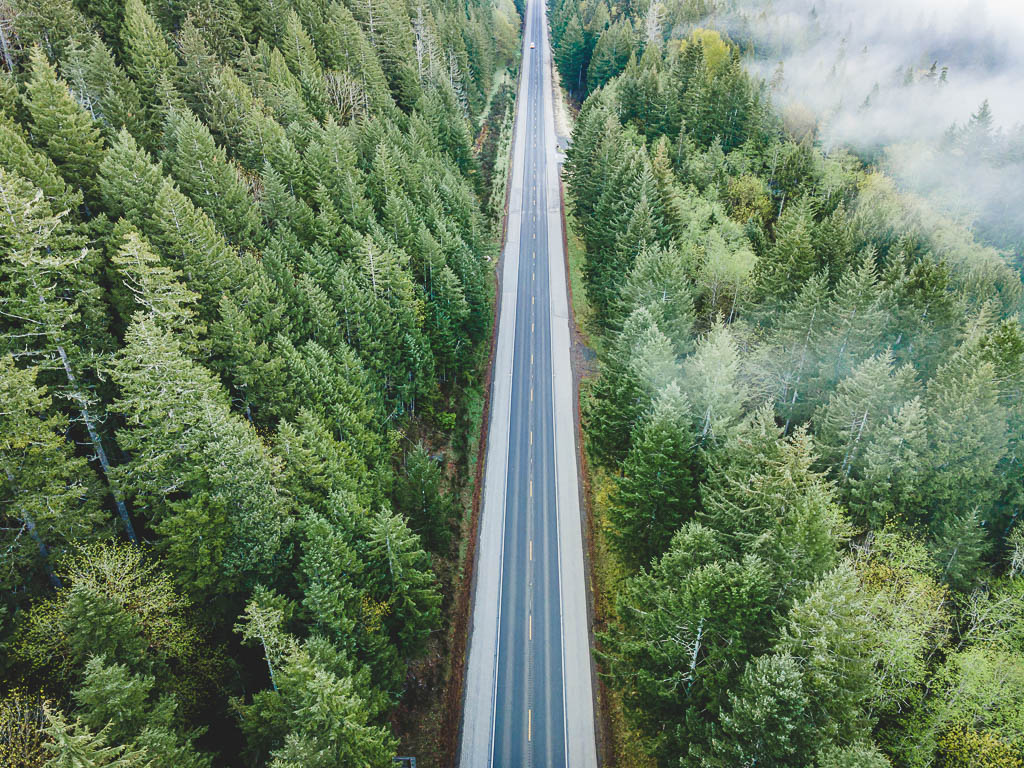The cool, crisp, sunlit morning peered through our windshield as we headed to our hiking destination. We were yapping away when a driver on the opposite side of the highway flashed his lights.
“Must be a cop close by.”
I was wrong—four cars were parked on the shoulder of both sides of the road, but I also noticed the poor deer lying on the ground, obviously hit. Through my cracked window, I heard one of the drivers say something about calling Fish and Wildlife.
“I think she’s dead.”
Scott agreed.
We drove for another minute or so. What started as quiet thoughts quickly shifted to shouting, What the hell is wrong with you? Turn around! This is not like you! Turn around!!
“Hunny? Something in me feels we should turn around.”
Scott didn’t ask any questions and nodded, “OK.”
***
The shouting animal rescuer in me wasn’t wrong. I’m unsure why I assumed the deer was dead. It had been a while since I had rescued a wild animal, but when humanly possible, I had always tried to stop if I saw an animal lying on the road. If they were dead, I would move their bodies to a safer spot so the wild scavengers may feed on them, avoiding traffic themselves.
I’m not making excuses. I was disappointed in myself, but I know I’ve also been dealing with burnout, not with the act of rescuing but with the authorities I wish I could count on. They either lacked empathy and/or could not do more based on the weak or nonexistent animal welfare laws. Of course, and unfortunately the latter leaves everyone’s hands tied.
In the most recent incident, an animal control officer stopped by the house I called about but actually told me that the emaciated dogs and their missing puppies were under the “care” of someone who “is doing their best they can to make a living.” I’ve worked in animal rescue for over 40 years. What she said did not surprise me; instead, it exhausted me. In those years, only a handful of officers have gone above and beyond for the animals. If it weren’t for my insistence, there would be less.
The feeling of who-do-I-turn-to-now helplessness has taken a toll on my mental and emotional health. I won’t give up on these animals that can’t speak for themselves, but I do admit that the solitude of the fight is wearing me down.
***
Returning to the scene, we noticed only one car remained—the same driver who had asked to call Fish and Wildlife. The deer was further down the road. I advised Scott to park as close as possible to her. We both gasped, watching her chest rise and fall. “Oh man, she’s alive.”
I slowly approached the poor girl and softly spoke to her, hoping not to cause any more shock. I gently placed my hand on her. She flinched a little but calmed soon after.
The sheriff arrived to assist the man who clearly hit the deer with the corner of his car. Part of his bumper was gone.
I continued to sit with the deer while Scott stood at a distance, watching me try to comfort her.

I called Fish and Wildlife. Surprisingly, I got through quickly. The man I spoke to immediately showed patience after hearing I was slightly emotional. He asked me to check for broken bones. It had been decades since I worked at animal hospitals, but I did my best. I checked her legs, ribs, and spine. All seemed intact, but I explained that she may have been hit in the head, especially since she bled tears.
He said, “Go about your day and give the deer a couple of hours. Deer are resilient and are known to walk from vehicle injuries.”
I asked, “Even if she was hit in the head and bleeding from her eye socket? I just don’t want her to suffer so much.”
“As long as there are no broken bones, she could get up from this. Just go about your day, and we will come by in a couple of hours. If she’s still there, we will euthanize her.”
I thanked him and hung up.
As I sat beside the deer, staying quiet, caressing her neck and head ever-so-gently, my mind rewound to when I was a child in the Appalachian forest. I expressed the same enthusiasm and love for deer, raccoons, frogs, fish, spiders, moths, and bears as I did when I came home to my pets. I didn’t see them so differently to deserve more or less of my compassion.
While petting this perfect, sentient creature, I smelled her wild, felt her heartbeat and her perfectly soft coat keeping her warm. Her hooves were sheen without chips. This moment felt familiar to me. My heart began to ache. I wanted her to live, but I also could not bear her to suffer. What a battle of thoughts. She lay still for the most part, except for every time a truck passed by, she flinched. I didn’t blame her, as I reacted, too. Those unnatural sounds can be frightening to any wild animal, let alone an injured one.

After decades of helping domestic and wild animals, I knew the FWS employee/ranger was right about how resilient deer are. Still, I couldn’t help but think about how differently we behave when humans are injured. We call 911. The authorities, fire department, and ambulance arrive as soon as possible. They place the injured person on a stretcher and take them to a hospital to provide aid and rehabilitate them so they can return home.
I couldn’t help but notice the lack of empathy for other sentient beings. Most times, wild animals’ only options are to suffer, to come out of it, or euthanasia. No ambulance is coming, dear friend. We wouldn’t dare tell someone to “Go about your day” if a human was hit by a car and bleeding from their eyes.
Humans can be resilient animals, too. Why shouldn’t we be sympathetic to an injured animal’s horrifying situation and try, at the very least, to comfort them? You don’t have to say much; being by their side may help calm their shock and fright before hopefully showing their resilience.
Fifteen minutes had passed, and finally, the sheriff parked behind our car. He gave me a warm smile and asked how the deer was doing. I told him what FWS had recommended even after telling the ranger she had a serious head injury. The sheriff kindly responded, “I’ll do it.”
Of course, this threw us off guard. I asked, “Really?”
“Yes, but I’ll wait til you leave.”
“If you don’t mind, I prefer to wait in the car.”
He fumbled his words as I surprised him. “Sure. I mean, if you don’t get bothered…”
I interrupted, “Witnessing an animal get euthanized via a gunshot would not be my first. I understand and appreciate your willingness to end her suffering.”
He tipped his hat and nodded. He said he’d be right back.
I had a heartbreaking moment with the deer. “It’ll end soon, sweetie,” I told her I loved her and got up to join Scott. Deep down, I hoped she would prove me wrong.
To our surprise, the young deer bolted up and struggled to gain her balance. She was dazed and loopy but managed to stand on all fours. Nobody moved or said a word. She slowly and clumsily walked up the hill. With each step she took, she tripped but didn’t fall. Blood gushed out of the one eye we could see, but she blinked a few times and continued to the top of the hill. There, she stood still for a while.
Once we realized she might have a chance, I turned around and held my hands together in Namaste, thanking the sheriff repeatedly. His eyebrows lifted with relief, and he smiled back. Scott later told me he gave us a thumbs up and could see the relief on his face, which warmed my heart.
When Scott and I took a couple of steps toward our car, I watched the deer’s head snap back at us as if she didn’t realize we were there. I’m sure she was too dazed, and I wouldn’t doubt she had, at minimum, a severe concussion. The deer stared as I sat inside the car. Soon after, she clumsily disappeared into the forest.

I was surprised to see her maneuver her head that way. I do hope that the FWS ranger is right in this case. Deer are resilient. Still, this resilience isn’t always the outcome, especially after being struck in the head by a car that had to be driving at a minimum of 50mph on a 60mph highway. To give you an idea, most drivers drive over the speed limit on this road.
A wonderful product that has worked for us in avoiding hitting deer so far is deer whistles, which you can adhere to the hood of your car. I’ve avoided three near-crash incidents because the whistles cause deer to flinch, even bolt to a halt, or steer in the other direction. They’re inexpensive and can be found at your local hardware or auto parts store.
Note: These whistles are sensitive to pets, too.
Back on the road, I told Scott I wanted to write about my thoughts on this experience. He smiled and said he took photos. “It’s not often someone would turn around and stay with an injured wild animal. Not everyone has that kind of empathy.” Although I appreciated what he said to me, I felt disheartened.
Why is empathy so difficult for people to show our non-human companions? Why is it easier to turn our backs on those in need or, worse, in distress? Why are humans still behaving like we are more valuable than other animals? 2025, and here we are. We are such a backward species, undeniably slow in learning from the mistakes of our parents, grandparents, great grandparents…our ancestors. Will we ever evolve?
I want to end this experience with a reminder…take the time to show the empathy you would like if you were in the same position.

